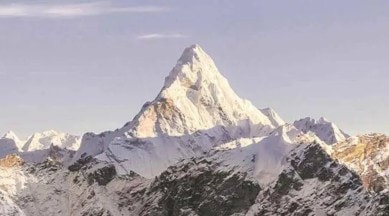Humans are leaving behind microbes that could live for hundreds of years on Mount Everest
Humans could be living behind bacteria and other microbes that could lie dormant for centuries on Mount Everest and surrounding regions.

South Col is the rocky dip between Mount Everest and Lhotse, its sister peak. It is often windswept and relatively free of snow. Here, hundreds of mountaineering enthusiasts pitch their final camp each year before trying to scale the world’s tallest peak. According to new research, these mountaineers are also leaving behind a legacy of bacteria that could live for hundreds of years.
The study led by researchers from the University of Colorado shows that the hardy microbes left behind can withstand the harsh conditions in the boulder and can lie dormant in the soil for long periods.
monthly limit of free stories.
with an Express account.
According to the university, scientists have not been able to conclusively identify human-associated microbes in samples that were above 26,000 feet. This study could mark the first time that next-generation gene sequencing technology has been used to analyse soil from such a high elevation on Mount Everest.
This allowed researchers to gain new insights into them. They were particularly impressed by the fact that the microbes that evolved to thrive in warm and wet environments, like in our noses and mouths, were tough enough to survive in such harsh conditions. The peer-reviewd research has been published in the journal Arctic, Antarctic and Alpine Research.
Learning about the bacteria that can survive the extremes
The researchers hiked up as far as possible from South Col to collect soil samples that could be analysed at university labs. There, they used advanced gene sequencing technology and more conventional culturing techniques to identify the DNA of living and dead microbes in the soil.
They also carried out extensive bioinformatics analyses of the DNA sequences to understand the diversity of the organisms and how abundant they were.
Most of the DNA sequences they were able to identify turned out to be similar to hardy “extremophilic” organisms that are usually detected in other sites with extreme conidtions, like in the Andes or in Antarctica. The most abundant organism they found was a fungus in the genus Naganishia that can withstand high levels of cold and UV radiation.
Apart from that, they also found microbial DNA for organisms that are associated with humans. This includes Staphylococcus, which is one of the most common skin and nose bacteria, and Streptococcus, which is dominant in the human mouth.
Usually, microbes often succumb in high elevations due to ultraviolet light, cold temperatures and lack of water. This means that only the robust creatures survive. Most of the microbes, like those carried by humans, become dormant. But there is a chance that some organisms can grow briefly when water and some rays of sunlight is enough heat for it momentarily.
The researchers, however, do not expect these microbes on Mount Everest to have a significant impact since even the toughest of microbes might not be able to leave the mountain and its surrounding regions.